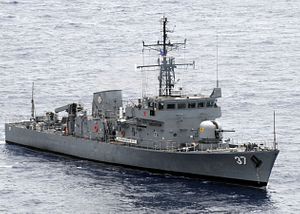A recent State Department report highlighted the expansion of U.S. maritime assistance and capacity building in South East Asia. This document falls firmly within the guidelines set forth in the Cooperative Maritime Strategy, as well as in the State Department’s longstanding preferences with respect to regional engagement.
In addition to improving response time, these sorts of agreements will also enhance the ability of the USN to carry out cooperative disaster relief, as it will help create partnerships and familiarity with host state response organizations. We have more than enough evidence that the increasing concentration of Southeast Asian populations in the littoral will radically increase the incidence and severity of natural disasters, which almost invariably lead to political, social, and economic disruption.
Such maritime assistance programs do not guarantee that the recipients will support the geopolitical aims of the United States in a high diplomatic sense; the friends we’re winning and influencing have their own interests, and in an actual struggle for power in East Asia would have their own reasons for supporting one side or the other. But let’s be frank; any program that “intends to provide up to $18 million in new assistance to Vietnam to enhance the capacity of coastal patrol units to deploy rapidly for search and rescue, disaster response, and other activities, including through provision of five fast patrol vessels in 2014 to the Vietnamese Coast Guard” also increases the combat capacity of Vietnamese maritime forces, as well as Vietnam’s ability to maintain a presence in areas that it contests with China. There’s surely a trade off between disaster preparedness and external defense, but a professional force with modern equipment can, for a time, become better at both.
This goes beyond “soft power;” it fits better with Joseph Nye’s conception of “smart power,” which involves utilizing the military and diplomatic tools of the United States to achieve national objectives. In this case, the United States is leveraging the “pointiest” part of its national security toolkit to achieve objectives normally associated with soft, diplomatic power. Not incidentally, increased interaction with the officers and personnel of Southeast Asian nations, and with the social and economic geography of the region, nearly guarantees that the United States will have a more full intelligence picture of the Southeast Asian littoral.
These programs can be tough to sell to Congressional budget hawks, most of whom hold considerable suspicion of any project that smacks of foreign aid. This perspective sets aside concerns over the material growth of the Chinese Navy, or over increased Chinese territorial assertiveness. However, it certainly helps to accomplish a set of national values that the United States has long sought, including the security of maritime transit and a reduction of the most disruptive effects of natural disasters.

































